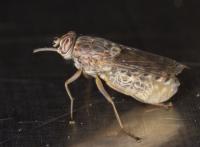
This is an image of tsetse fly. An international team of researchers led by the Yale School of Public Health has successfully sequenced the genetic code of the tsetse fly, opening the door to scientific breakthroughs that could reduce or end the scourge of African sleeping sickness in sub-Saharan Africa. The study is published in the journal Science.
It took nearly 10 years and more than 140 scientists from numerous countries to map the genome of the fly, also known as Glossina morsitans. Tsetse flies are the sole insect vectors of a disease that threatens the health of millions of people and devastates livestock herds.
The genetic blueprint will provide researchers with the codes for the proteins that make up the tsetse fly, which is slightly larger than a common housefly. It is essentially a "parts list" of what the organism is made from. Access to the blueprint is expected to accelerate research into the tsetse fly's unique biology and promote the development of improved tsetse control methods as well as the development of new control strategies.
"This is a major milestone for the tsetse research community," said Geoffrey M. Attardo, a research scientist at the Yale School of Public Health and the paper's lead author. "Our hope is that this resource will facilitate functional research and be an ongoing contribution to the vector biology community." The effort has already resulted in eight research articles that expand on the genome data using functional genomics methods and are being published under the banner "Tsetse Genome Biology Collection" in the PLOS-wide journals.
While there are drugs to combat sleeping sickness, they are expensive, have many undesirable side effects, and are difficult to administer in wide swaths of rural Africa where the disease is most pronounced. Left untreated, sleeping sickness is 100% fatal.
The researchers had to overcome numerous challenges — technical, biological and economic — in order to decipher the complete sequence. As with most genome projects the researchers had to limit their analysis to a single genetic line in order to improve the assembly of small fragments of sequence data — thousands of letters of code — into large scaffolds that contain millions of letters of code. This became an issue because only a small amount of genetic material is obtainable from each fly, and unlike other insects, one tsetse female gives birth to very few offspring. The genome contains approximately 366 million letters of code, which is equivalent to about 10% of those in the human genome.
School of Public Health professor Serap Aksoy helped initiate the collaborative research project in the early 2000s when she and a small group of other researchers concluded that progress against the disease and new tsetse-based control opportunities would be stymied unless the biological and chemical underpinnings of the organism were completely understood. The consortium was initiated with seed funding from the World Health Organization. "We are very happy to finally reach the finish line," Aksoy said. "Our hope is that tsetse research will now enjoy broader participation from the vector community and lead to improved and novel methods to eliminate disease."
Source : helen.dodson@yale.edu
 Print Article
Print Article Mail to a Friend
Mail to a Friend
